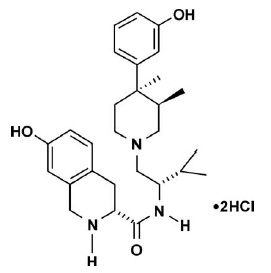jdtic.com

JDTic is the world's first selective, orally active kappa opioid antagonist
("suggested starting dose for human-sized primates 100mcg every other day")

JDTic is the world's first selective, orally active kappa opioid antagonist
("suggested starting dose for human-sized primates 100mcg every other day")
Throughout my central nervous system, dynorphin's ability to bind to kappa-opioid receptors has been inhibited. The responsible agent? JDTic. A product of rational drug design out of F. Ivy Carroll's lab at RTI, JDTic is the world's first orally active kappa antagonist. An RTI annual report lists it as having been discovered in 1989, but it didn't turn up in the USPTO's patent office until 2001. Another decade went by before the first clinical trials began in 2011, and their results have yet to be released to the public despite the study's termination for unknown reasons.
What's all the fuss about this little known stereoisomer, and why's it so important compared to its boring cousin JLTic? JDTic selectively antagonizes kappa; within the CNS there exists a kappa-mu axis, simplistically, pain and pleasure (ignoring delta, OLR, and the various receptor heterodimers). The brain's reward circuitry comes with its own negative feedback system. Prior to JDTic only a portion of this spectrum had been fully explored, largely thanks to derivatives of mu's namesake morphine, and its synthetic and natural opiate relatives. Kappa agonists exist, such as Salvinorin A, and their effects are known to be profoundly dysphoric. (Salvinorin A's action is complicated by its dopaminergic effects, but more selective ligands do exist.) Perhaps an agent which deactivated the brain's negative reinforcement system would help treat depression, anxiety, drug withdrawal, etc. . and if not rewarding in itself the liability of abuse potential would be avoided.
The good news, at least in my case, is that it appears to work. Life is less stressful, the days are more beautiful, and even my sense of humor has improved. But these remain early times when it comes to this self-experiment. Animal models in published literature used doses of 1, 3, or 10 milligrams per kilogram. Interspecies dose extrapolation is sometimes calculated through body surface area rather than weight, but this still left us with an unusually large dose. So we started at 1mg and slowly worked our way up.
On 1mg there was apparent nootropic action (compare to literature which shows agonists having negative cognitive effects), but not much else definitive. Occasionally I felt a warm glow throughout my body, normally upon waking up about 12 hours post-dose. But it was not the response which had been hoped for. Having moved up from 1mg, the next logical step was down, and here is when the fun really started.
One milligram was placed into a volumetric flask and dissolved in 10mL of distilled water. Fortunately JDTic is quite soluble in H2O. Its sub-cutaneous bioavailability is higher than when administered per os, but why bother. Every 48 hours 1mL is administered sublingually, this amounts to 100 micrograms, or one-tenth of the lowest dose used in the clinical trial. The effects are dramatic, yet subtle, like any good drug should be. As hoped, it is not rewarding in itself, but life seems richer and the days more infused with meaning. Life's events are somehow funnier. Music sounds better, and activities which I normally enjoy are even more rewarding. This includes social interaction. I begin wondering what life was like without JDTic. From this vantage point I'm not sure I really know.
Blood pressure remains normal. Routine CBC checks out OK. Electrocardiography is as of yet to be performed; QT intervals need to be monitored in case of any promiscuous hERG binding, a notorious anti-target but most likely not an issue at this dose, and undetectable as far as statistics are concerned in such a small scale study.
The above is my personal response, and while others have had similar responses, some have not reported any significant effects. At this point in time there is a wide field of doses in the microgram range which remain unexplored. JDTic is perhaps more effective at preventing stress, while reversing it is another matter, harder to study and more open to confounds. JDTic's apparent long duration of action also remains open to study. For instance, what effect would weekly doses have? JDTic has yielded many secrets, but questions remain unanswered.
MDK
Opioids.wiki
JDTic (Wikipedia)
e-mail
dave@jdtic.com